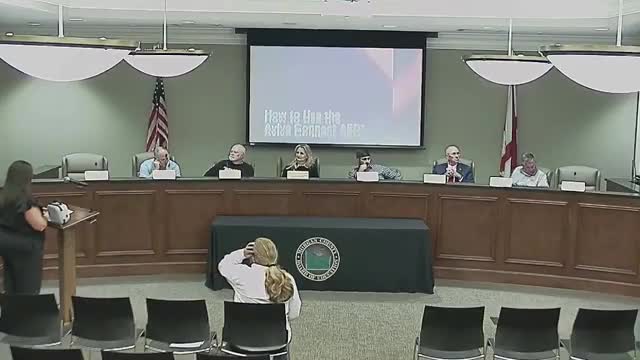Morgan County Schools deploys Avive Connect AEDs; district nurse outlines costs, GPS/incident features and fleet goals
October 10, 2025 | Morgan County Schools, School Districts, Alabama
This article was created by AI summarizing key points discussed. AI makes mistakes, so for full details and context, please refer to the video of the full meeting. Please report any errors so we can fix them. Report an error »

Miss Wilburn, district nursing staff, demonstrated the Avive Connect automated external defibrillator (AED) product the district is deploying and outlined costs, management features and the district’s fleet goals.
"The Avive Connect AED makes it easier than ever for anyone to save a life in the event of a cardiac arrest," Miss Wilburn said, explaining the device’s guided steps, Spanish-language and child modes, built-in training cartridge and an incident-reporting system accessible via QR code or the vendor’s RealConnect portal.
Wilburn said the device weighs about 2.2 pounds, uses a rechargeable power pack (no disposable batteries), and requires about four to six hours to charge; she said a full charge typically lasts six to eight months under normal conditions. She described the vendor’s fleet-management service (RealConnect): the first year of program management is included with the unit purchase; the district pays an annual subscription afterward for device monitoring and logistics, including overnight replacement pads after an actual use.
Wilburn gave cost and inventory figures: the unit with its carrying case costs about $1,900 and includes a one-year RealConnect program-management subscription; the Avive pads have an eight-year shelf life and the vendor replaces pads at year four as part of the management service. She said the district has replaced 27 units so far and that the current fleet sits at about 70 devices; she estimated the district needs "about 40 to 45 more" units to complete fleet replacement and 50–55 to add traveler units for off-campus athletics.
Wilburn said the Avive devices provide GPS coordinates and real-time information to local emergency medical services when activated, including whether the unit was in child mode or Spanish mode and the device’s exact location on a campus. The AED also produces an incident data report after use; EMS and treating clinicians can retrieve that report via QR code or the vendor portal.
Wilburn said Avive has made Morgan County a showcase/case study and that the vendor promoted the district’s deployment on social media. She said she plans to continue seeking state or budget funding to replace the remaining fleet. "I would love to get more money from the state or budget wise to replace our entire fleet," Wilburn said.
Board members asked about unit placement, charging and management; Wilburn said some AED boxes are located near electrical receptacles and that nurses typically return units after hours to charge them when needed. She also noted an Alabama statute she said requires traveling AEDs for off-campus sports activities; the presentation did not include a specific citation to the statute.
"The Avive Connect AED makes it easier than ever for anyone to save a life in the event of a cardiac arrest," Miss Wilburn said, explaining the device’s guided steps, Spanish-language and child modes, built-in training cartridge and an incident-reporting system accessible via QR code or the vendor’s RealConnect portal.
Wilburn said the device weighs about 2.2 pounds, uses a rechargeable power pack (no disposable batteries), and requires about four to six hours to charge; she said a full charge typically lasts six to eight months under normal conditions. She described the vendor’s fleet-management service (RealConnect): the first year of program management is included with the unit purchase; the district pays an annual subscription afterward for device monitoring and logistics, including overnight replacement pads after an actual use.
Wilburn gave cost and inventory figures: the unit with its carrying case costs about $1,900 and includes a one-year RealConnect program-management subscription; the Avive pads have an eight-year shelf life and the vendor replaces pads at year four as part of the management service. She said the district has replaced 27 units so far and that the current fleet sits at about 70 devices; she estimated the district needs "about 40 to 45 more" units to complete fleet replacement and 50–55 to add traveler units for off-campus athletics.
Wilburn said the Avive devices provide GPS coordinates and real-time information to local emergency medical services when activated, including whether the unit was in child mode or Spanish mode and the device’s exact location on a campus. The AED also produces an incident data report after use; EMS and treating clinicians can retrieve that report via QR code or the vendor portal.
Wilburn said Avive has made Morgan County a showcase/case study and that the vendor promoted the district’s deployment on social media. She said she plans to continue seeking state or budget funding to replace the remaining fleet. "I would love to get more money from the state or budget wise to replace our entire fleet," Wilburn said.
Board members asked about unit placement, charging and management; Wilburn said some AED boxes are located near electrical receptacles and that nurses typically return units after hours to charge them when needed. She also noted an Alabama statute she said requires traveling AEDs for off-campus sports activities; the presentation did not include a specific citation to the statute.
View full meeting
This article is based on a recent meeting—watch the full video and explore the complete transcript for deeper insights into the discussion.
View full meeting
